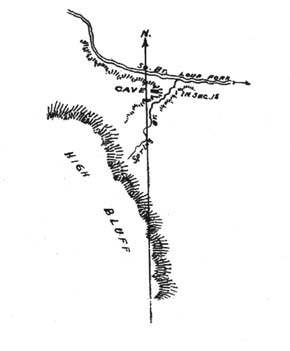A REMINISCENCE OF GOVERNMENT
SURVEYING
By Robert Harvey
I surveyed the township lines of Custer
County for the government in 1872, and by the last days of July
had completed all but six miles of such lines south of the Fourth
Standard Parallel. On a July day I camped at the corner Townships
15 and 16 north, Ranges 23 and 24 west, near the northeast edge of
a beautiful round flat valley.
The depression is, no doubt a very remote lake
bed, or basin formed by the rocking of an ancient iceberg.
One afternoon I started north on the last six
miles of the range line of this part of the work and ascended the
long grassy south slope of a high hill or promontory. After
considerable labor and fatigue, I reached the summit of the clean
cut northeast rim. The diagonal descent along the steep northeast
slope was attained with considerable difficulty, and having
reached the bottom I found that the bluffs' dark shadows cast far
out into the valley, rendering farther progress that evening
impossible. We proceeded to camp, which we found on the right bank
of the south branch of the South Loup River, designated in the old
geographies as "Carrey's Fork."
Next morning we resumed the work of projecting
our abandoned line northward, and at the half mile corner between
sections 13 and 18, we crossed a small spring brook having its
source in springs under the east slope of the high bluff. A little
farther north we ascended an elevated clay spur formed by the
river on the north and the little brook on the southeast. The
bluff terminated a little east of our line in a low bottom covered
with wild hemp and sunflowers.
Crossing this spur I noticed a deeply cut wagon
track, which appeared to have been made in soft wet ground and
then grass grown. This excited my curiosity and turning down the
trail a few yards I came upon a cowbell and the spring of a wagon
spring seat, common at that period. Descending to the low bench I
passed to the left along the foot of the spur and near its point I
suddenly came upon the door of a cave which was set flush with the
perpendicularly cut bank.
Pushing open the door I entered a room
containing a fireplace at the north end, a single sleeping bunk at
the south end and an old rough board table. Evidently it was the
kitchen, dining room, reception hall, parlor, and cook's sleeping
room. Passing through a door in the partition I
AN EXPERIENCE IN OMAHA
By Casper E. Yost
Mrs. Minnie P. Knotts, Secretary,
Nebraska Territorial Pioneers' Association,
Lincoln, Nebraska.
Dear Madam:
The following is in compliance with your
request that I write a few words, if no more:
On April 20th, 1864, I arrived in Omaha in a
lumber wagon which also contained my partner -- some law books and
a high hat. We had started from Ypsilanti, Michigan, not knowing
exactly where we would locate. We arrived at Davenport, Iowa, and
my partner desired to locate there. I said no, that I thought Des
Moines had a better future and he agreed to go to Des Moines.
Arriving at Des Moines we were told wonderful stories of the
future of Omaha. Having decided to go to Omaha, we hired a man and
team to deliver us there. We arrived in Omaha and as we did not
have money to go any further West, we located here of necessity.
We put up at the Douglas Hotel. On the next morning I started for
the court house with my high hat. I had not gone more than a block
when a man came up behind me and said, "You son of a gun, where
did you get that hat?" I turned around and found the man with a
revolver on each side of him in a holster and "drunker than a
lord." I said nothing, but took off that hat and walked back to
the hotel and never again did I wear it. I then went to the court
house and the court being in session, I listened to the
proceedings. The late Hon. John I. Reddick was addressing the
jury. His coat was off, and the part of his talk that made the
most impression on me was when he said, "Gentlemen of the jury,
west of the Missouri river modesty adorns a woman and is a curse
to a man." At that date Omaha had a population of about
twenty-five hundred, but they claimed it was more and have from
that date to the present, claimed a greater population than they
had.
Very truly yours,
C. E. YOST.
35



